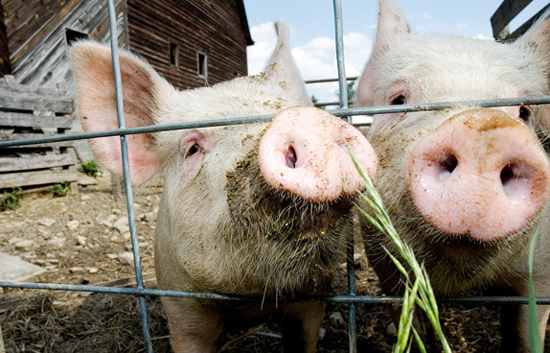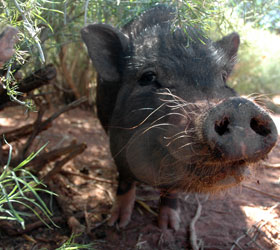Testing Weapons on Animals
Is it right to rope them in on our human wars?

(See also Michael’s column Animals, Conspiracies & ‘The Avengers’)
Is it justifiable to try out weapons of war on non-humans?
A recent report in the British Daily Mail focuses on how military scientists are testing the effect of explosives on pigs.
Why pigs? Many of their organs, including their skin, are closer to humans than most other animals. (That’s why they’re also used for organ transplants.)
The story (not for the faint of heart) begins thus:
“Anesthetized, but still very much alive, a pig lies on a raised platform in the middle of a field deep in the Wiltshire countryside.
“Like a giant sausage roll, the animal has been wrapped in bullet-proof Kevlar sheeting to protect it from shrapnel. The blast wave from the explosion will, however, cause it internal injuries.
“These will be exacerbated by an operation that has already been performed on the animal that allows a third of its blood to be drained (mimicking a massive hemorrhage) and measured precisely.
“For up to ten minutes following the blast, the pig will lie like this, untended. Then scientists will move in to stabilize the animal, measure the blood loss and check its responses to medical intervention.
“In all, 18 pigs are blown up in this way. Some do die instantly as a result of the blast, while others will survive for as long as eight hours.
“But, come the end of the experiment, all will be killed. No doubt, there are those who find it hard to believe animals continue to be used barbarically in this way in the name of science.”
In the past five years, 119 live pigs have been blown up with explosives by the U.K.’s Ministry of Defense. And 75,000 more animals of all kinds have been used in other military experiments. In 2009, that included 96 pigs, 149 monkeys (a near three-fold increase on the previous year), 190 guinea pigs and more than 7,500 mice. The “procedures,” all funded by the taxpayer, included exposing guinea pigs to nerve agents and marmoset monkeys to anthrax.
Those numbers, of course, pale when compared to what goes on in the United States – where figures are harder for investigative journalists to track. Military tests on animals in the U.S. are classified as “top secret.” But in April 2009, USA Today reported that:
“Military researchers have dressed live pigs in body armor and strapped them into Humvee simulators that were then blown up with explosives to study the link between roadside bomb blasts and brain injury. . . . The next round of the testing is scheduled for later this year.”
 Each year, hundreds of thousands of primates, dogs, pigs, goats, sheep, rabbits, cats, and other animals are hurt and killed by the Department of Defense in experiments that cost of hundreds of millions of dollars. (See, e.g., U.S. Department of Defense, The Department of Defense Animal Care and Use Programs Fiscal Year 2002-2003).
Each year, hundreds of thousands of primates, dogs, pigs, goats, sheep, rabbits, cats, and other animals are hurt and killed by the Department of Defense in experiments that cost of hundreds of millions of dollars. (See, e.g., U.S. Department of Defense, The Department of Defense Animal Care and Use Programs Fiscal Year 2002-2003).
Not surprisingly, the British and U.S. governments argue that such experiments provide critical lessons in how to save lives in the event of a conventional or biological attack – not only on soldiers in the field, but also on the civilian population.
In December, 2009, Rep. Bob Filner (D. Calif.) introduced a bill that would replace animals with dummies. Commenting in the Washington Times, Jim Hanson, a former special-ops soldier, writes:
“The euphemistically named BEST Practices Act is anything but that. The best practice for a new combat medic is treating a living being. That is a harsh reality, but it is the truth. Currently, the military conducts what is called live-tissue training with goats and pigs. The animals are anesthetized and then given wounds the medics and doctors are likely to see in combat, and the medics perform the appropriate procedures to treat them. The animals are not a perfect analogue to a human casualty, but they provide one thing no simulation or dummy can: the visceral reaction each medic must face when a life is in danger.”
Not so, responds Rear Admiral Marion Balsam, a retired U.S. Navy physician:
“Pigs’ and goats’ bodies are very different from those of humans … Wounding and killing animals are not the most effective ways to teach medics how to save human lives.
“Researchers already have developed various simulators that accurately replicate human anatomy. … The military should end the use of animals for medical training and invest in these more modern approaches that provide the best training to care for our troops.
More than 100 years ago, author Mark Twain offered an altogether different argument against experimenting on animals:
“I believe I am not interested to know whether vivisection produces results that are profitable to the human race, or doesn’t. The pain which it inflicts on unconsenting animals is the basis of my enmity toward it, and it is to me sufficient justification of the enmity without looking further.”
In the final analysis, the best way to save our sons and daughters from the terrible injuries of the battlefield is not to send them off to kill and die in foreign lands.
If that seems too idealistic for our times, perhaps those who send them to war should be brave enough to volunteer as the subjects of these experiments.
~~~~~~~~~~~~~~~~~~~~~~~~~~~~
(See also Michael’s column Animals, Conspiracies & ‘The Avengers’)
